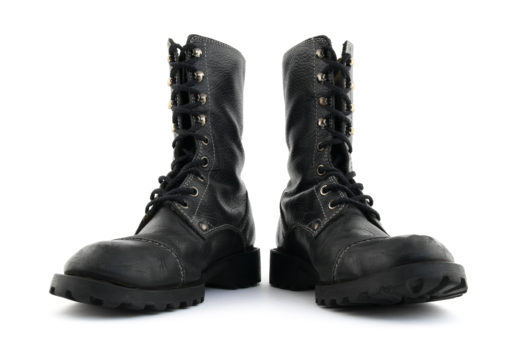
Although lacing boots are a necessity, it can be fun too. According to Dr. Polster, a boot with two rows of six eyelets have 43,200 different ways a shoelace can pass through every eyelet – with the condition each eyelet must contribute to actively closing the boot. However, not every lacing technique is aesthetically pleasing.
We’ve shortlisted the most popular ways to lace hiking boots, tactical boots, logger boots, army boots, sneakers, or running shoes.
Best Boot Lacing Techniques
How To Lace Military Boots – The Army Method
Sometimes the types of boots may determine the lacing technique. The Army lacing technique is popular under armed forces because the laces don’t snag on the side of the army boots, offering lots of slack in uncomfortable boot leather or new boots not broken in.
If you are making a statement with your boot shoelaces, this technique will show off your laces.

Tips To Lacing The Army Method
Before you start lacing, count the eyelets. You begin the lacing process differently with even-numbered eyelets to boots with uneven numbered eyelets.
Lacing The Army Method
- Start lacing uneven numbered eyelets from the outside to the inside, like you would start criss-cross lacing. With even-numbered eyelets, you start lacing from the inside to the outside.
- With the bottom eyelets laced, forming a straight line, pull strings upward to ensure you have the same length on both sides.
- Create a cross above the straight lace. Cross the lace diagonally over the tongue to the next eyelet on the opposite side, lacing from inside to outside.
- String the lace from the outside to inside through the next eyelet on the same side. Do the same with the lace on the opposite side.
- You’ll notice the lace pattern forms the cross at every second set of eyelets alternated by straight lines on the same side. Repeat these steps until your boots are laced to the top.
How To Lace Hiking Boots – The Standard “Criss-Cross” Method of Lacing
The standard criss-cross lacing technique is the most common lacing pattern; you’ll notices most boot purchases come with this boot lacing style. It is the most familiar technique to most people.
Tips to Lacing Hiking Boots Criss-Cross Pattern
Decide at the beginning from which side you will start lacing, from the right or the left. Continue the lace pattern for a neat and consistent crossing pattern.
The Standard Crisscross Pattern
- Create a straight lace through the bottom two eyelets. Start at the bottom and run each string tab from the outside toward the inside through one of the bottom eyelets.
- Make sure you have an equal amount of string on both sides by pulling strings upward.
- Make a cross above the straight lace. Bring the lace from the right side (or left side) over the boot tongue diagonally towards the next eyelet. String it into the eyelet from the top. Repeat the step for the other side.
- Continue lacing the entire boot to your ankle, maintaining the lacing pattern.
- Wrap excess boot laces around the ankles before tying the laces.
The Frictionless Cross-Lacing Method (X-Cross)
If you want your laces to last longer, the Cross-Lacing, also known as the Over-Under, is a lacing technique that causes less friction on the boot or shoelaces.
You can lace boots and sneakers with this method creating two levels of crosses.
Tips to Lacing Over Under
Odd or even-numbered eyelets will determine how you start lacing the lacing. With odd-numbered eyelets, string the bottom eyelet from the inside out and for even-numbered eyelets from the outside inwards.
The Cross-Lacing Method
- Lace the bottom eyelets creating a straight line.
- By holding the laces upward, check that the lace length on each side is the same.
- With even-numbered eyelets (work the opposite for uneven numbered), take the lace over the tongue and through the opposite eyelet from inside to outside. Pull laces through and repeat on the opposite side.
- Bring the lace over the tongue diagonally and pull through the next eyelet from inside to outside (the opposite for uneven eyelets). Do the same for the opposite side.
- Your laces form a cross at the top, and then it makes a cross under. Repeat these steps until the pair of boots are laced up to the ankles.
Heel-Lock Lacing Technique For Logger Boots
The Heel-lock or Lock technique is used when wearing logger boots, hunting boots, or hiking boots in rugged terrain. The lacing method offers more secure footing, reducing foot movement in the boot. You can lace logger boots with eyelets or hooks using this method.
The Lock technique is an excellent choice If you need extra ankle security for your running shoes.
Tips On Heel-Locking Pattern
If you lace the boots too tight, you may cause circulation problems in your feet. Resolve the issue by loosening the laces slightly.
The Heel-Lock Method
- Lace hiking boots, logger boots, or hunting boots from the bottom, like you, usually do, up to the second-last pair of eyelets. Make sure the lace end on the outside of the eyelets.
- String the lace vertically up the last eyelet from outside to inside, leaving a loop. Repeat on the other side.
- Cross over the lace diagonally, pushing it through the loop on the opposite side from the inside to the outside. Repeat on the other side.
- Pull tight to lock the heel in place and tie the boot laces typically.
Best Lacing For Support – The Ladder aka Paratrooper Method
The Ladder Lace method is popular under paratroopers because it offers extra security when landing on the ground. It works well with tall tactical boots with lots of eyelets.
Tips On The Ladder Method
The two-step lacing includes running the laces through eyelets closest to the string and running it through the lace loop without stringing through an eyelet.
The Ladder Lacing Method
- String the laces through the two bottom eyelets from the inside to the outside.
- Check if the strings are the same length by pulling them upward.
- String the laces vertically through the next available eyelet on the same side. Do the same on the opposite side. Your laces are now on the inside of the boot.
- Cross the lace over the tongue and through the loop created by the vertical eyelets on the other side. Avoid running the lace through an eyelet. Do the same on the opposite side.
- Repeat the previous two steps by running the lace through the next vertical eyelet on the same side of the lace and then through a vertical eyelet until you reach the top of the worker boot or running shoes.
More Lacing Techniques For Different Boots And To Relieve Foot Pain
- The best way to lace dress boots is using the straight bar method, where every row has straight lines with diagonal lengths hidden.
- Lace leather boots the same way you would lace worker boots.
- For secure footing, lace safety boots, the Paratrooper ladder lacing technique.
- If you don’t like work boots fitting too tight, you can use the 2-1-3 pattern.
- Knotted lacing and segmented lacing works well for narrow feet. Use surgical knots or reef knots to lock sections of the lacing, creating constant tension.
- Window lacing removes pressure for wide feet and foot shapes with high insteps. Create a window or box by lacing vertical eyelets instead of criss-cross over the pressure section.
- Toe-relief lacing removes pressure on the top part of your foot by skipping the bottom eyelets. If the boot has a gaiter catch, it is even easier to skip eyelets.
- Parallel lacing brings relief to foot pain caused by pressure spots on the central instep. The technique strings the lace across in a straight line and then skips an eyelet and strings the next one from inside out and across.
Keep an extra pair of laces; you never know when your current pair will break. When hiking or backpacking, always pack an extra pair of boot shoelaces. Make sure you buy the correct length laces; for example, 7-hole boots need 55 inches, 8-hole boots, 9-hole boots about 70 inches long laces.
Which lacing technique is your personal preference in lacing shoes and your work boots

